Stage 10 of the 2025 Tour de France saw the peloton finally hit a climbing stage, and yet aero bikes like Colnago Y1Rs and Cervélo S5 were still being used when teams have access to state of the art, featherweight climbing bikes.
That raises a simple question: Why? Shouldn’t every team with a lightweight climbing bike be pulling them out of the mechanics’ truck by now?
Perhaps you haven’t heard the news over the last few years, aero is everything… or not. The reality is a little more complicated than that, and ultimately it all comes down to the UCI.

The crossover point
When a brand — or a journalist — talks about how aero is everything, it’s really just a touch point on a larger conversation. When you move forward on a road with a bike, you have to overcome the forces that push you back. Primarily that means gravity and air resistance, but which one is the primary force depends on what the road looks like.
Actually, even that is a simplification. Your ability to slice through the air is always the final upper limit on your speed, but gravity will keep you from hitting that upper speed limit when the road turns up.
Said simply, going up a hill slows you down. Aerodynamics might be what puts an upper limit on your speed, but if the hill is too steep you’ll never approach that limit. That means there’s a crossover point where aero becomes more important than gradient, but it’s not absolute.
The crossover point has to do with speed. The faster you go the more aerodynamics come into play as the dominant force, and going faster means more power is necessary. Point the road up and you need even more power. All this is to say, the pro peloton hits the crossover point before you.
To get a better understanding of this, we can look at the Bianchi lineup. Why Bianchi when the headline is about the Colnago Y1Rs and Cervélo S5? Available data.
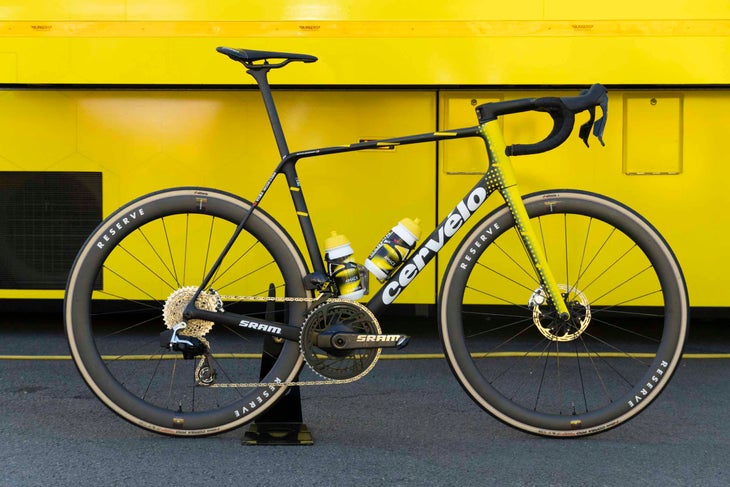
Colnago has the V5Rs and Cervélo has the R5 but there’s no data about the crossover point for either bike. Bianchi is different and we can use it as an example.
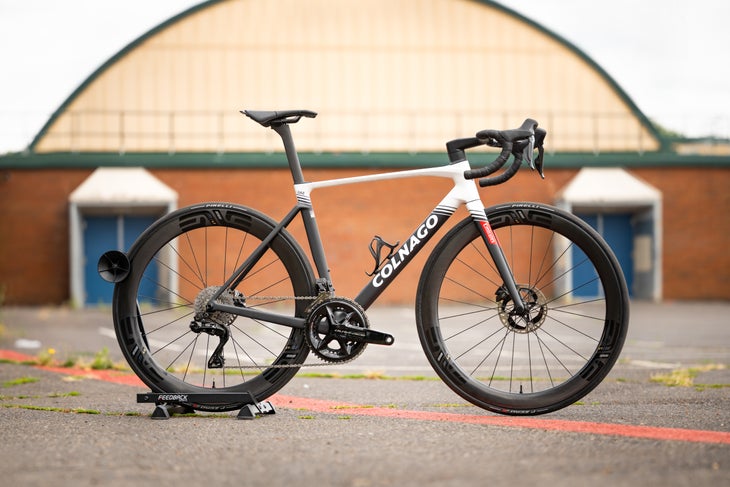
Like the Colnago Y1Rs and Cervélo S5, Bianchi has the Bianchi Oltre RC as an all-out aero bike. It’s heavier than the Bianchi Specialissima and while the numbers between the Bianchi bikes and the Colnago, or Cervélo, bikes won’t be exact comparisons, you can get a sense of where things stand.
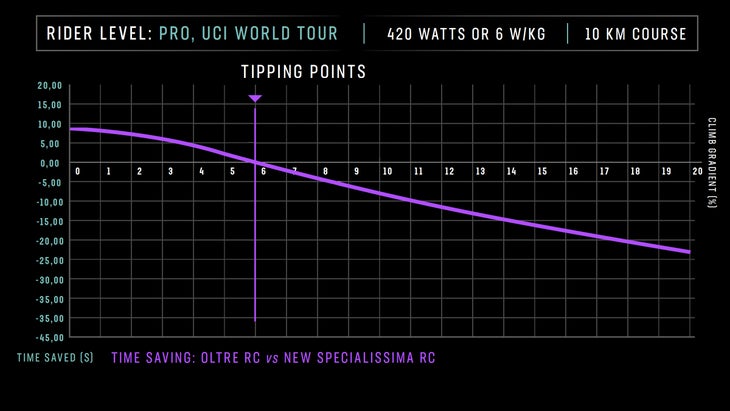
According to Bianchi, the tipping point for the Oltre vs the Specialissima is a 6% gradient. That means for a rider with an FTP of 6 watts/kg (as defined in by Bianchi) the lighter bike is only faster when the gradient is 6% or greater. Anything less and the aero bike is faster.
This is also a common number cited in off the record conversations with other brands, but Bianchi is actually publishing the number, so that’s who gets the credit. Keep in mind that assumes a modern lightweight aero bike and a modern aero optimized climbing bike. If you make the aero bike heavier or the climbing bike less aero, things will change.
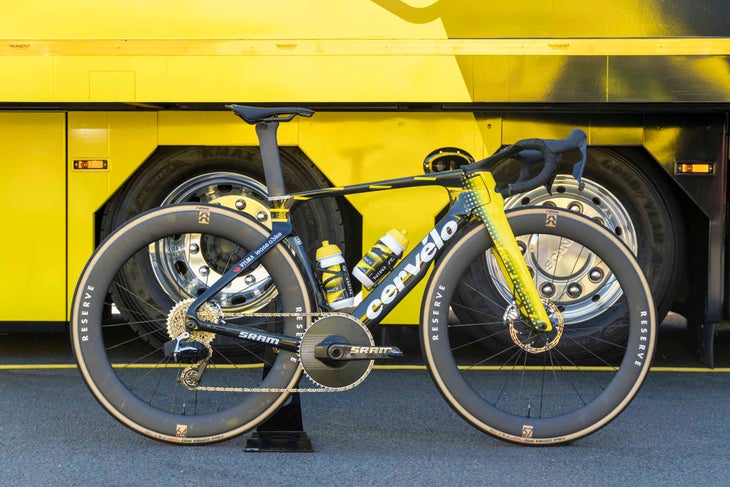
Why the Colnago Y1Rs and Cervélo S5 are being used in the mountains
With that understanding, let’s examine the actual route for the first mountain stage, stage 10. Surely there’s plenty of gradients above 6%, right?
| Name | Length | Gradient |
| Côte de Loubeyrat | 4 kilometers | 6.3% |
| Chanat-la-Moutyre | 2.2 kilometers | 6% |
| Côte de la Baraque | 4.8 kilometers | 7.4% |
| Côte de la Charade | 5.1 kilometers | 6.8% |
| Côte de Berzet | 3.4 kilometers | 7.4% |
| Col de la Moréno | 1.5 kilometers | 5.8% |
| Col de Guéry | 3.4 kilometers | 6.7% |
| Unclassified ramp after Lac Chambon | 2.3 kilometers | 7.8% |
| Col de la Croix Saint-Robert | 5.1 kilometers | 6.4% |
| Puy de Sancy (summit finish) | 3.3 kilometers | ~8% |
As you can see, there are lots of gradients above 6% but, and this is why aero is everything, that’s only a small portion of the overall route. Each of those climbs might be over 6% but if you analyze the entire route, only 4.24% has a gradient above 6%. In that context, reaching for the aero bike on a day like stage 10 makes perfect sense.
If you are curious about some actual numbers, well, no brand is sharing. What you want to see is an absolute CdA number, but no one is sharing that. For weight though, I can share my own measurements of the V5Rs, Y1Rs, and S5 in a size 54 (or equivalent) with top spec builds and ready to ride minus pedals.
| Bike | Weight |
| Cervélo S5 (SRAM RED XPLR with Reserve 57|64 wheels) | 7.36 kg |
| Colnago Y1Rs (SRAM RED with Enve 4.5 wheels) | 7.54 kg |
| Colnago V5Rs (Shimano Dura Ace with Enve 4.5 wheels) | 6.68 kg |
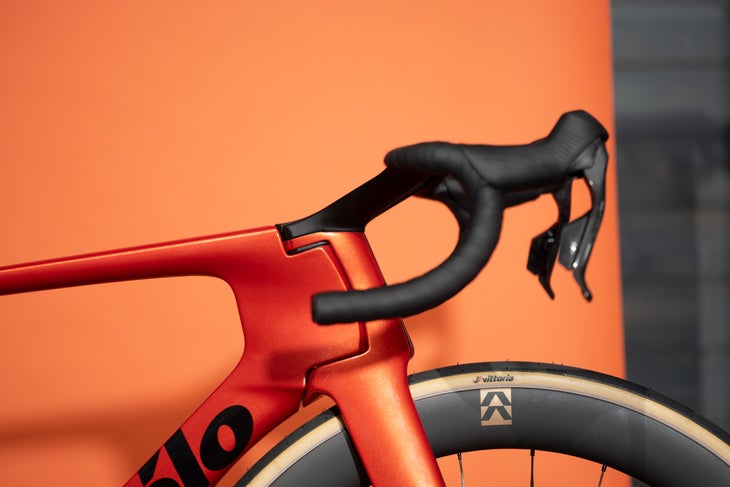
The UCI is the real reason the Colnago Y1Rs and Cervélo S5 are being used
Aero and weight will always be two oppositional forces. You need larger tubes for better aerodynamics and you need smaller tubes for better weight. If a bike could be as light as a manufacturer was able to dream it then you’d see a bigger split between aero bikes and climbing bikes and the tipping point would change. Instead the UCI is artificially creating a convergence.
On the aero side there’s limits not only to the shapes possible for a race bike but also for the overall design. UCI legal bikes have to look like bikes as the UCI defines them, and so the tubes can only be so deep. That puts a hypothetical upper limit on aero efficiency and it’s likely we are getting close to that with bikes like the Colnago Y1Rs and Cervélo S5.
On the other side of things, there’s a minimum weight limit for race bikes. Brands can shrink tubes and optimize layups as much as they want but it’s been easy enough to hit the 6.8 kg minimum weight for a number of years.
With those two limits in place, it encourages bike companies to create one bike that does it all. Expand the tube shapes to the allowed limits then get clever with production to reduce the weight to the minimum. Right now that still leaves some room for innovation, but not a ton. Already the Trek Madone is a bike that hits close to the minimum weight (I measured 6.9 kg ready to ride minus pedals) while being one of the faster aero bikes. Without further rule changes it can’t be long before nearly every bike brand is able to get that close to the minimum without sacrificing aero, and at that point distinct aero vs climbing bikes will disappear.
For now, the Colnago Y1Rs and Cervélo S5 are seeing use in the mountain stages because the gradients aren’t steep enough for a big enough percentage of the stage. Modern aero bikes are light enough to be faster in all but the most extreme climbing situations.
